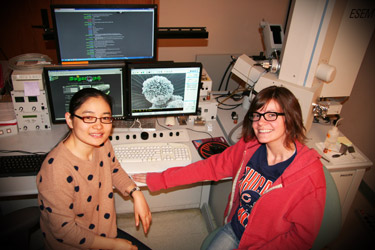Scott Robinson, manager of the Microscopy Suite at the Beckman Institute, and Cate Wallace, a microscopist in the lab, were hosting a series of Bugscope sessions with 7th grade science students from Mountain Ridge Middle School in Highland Branch, Colorado, when the unexpected happened.
Bugscope, which has just reached its 15-year anniversary, is an outreach effort on behalf of the Microscopy Suite staff that allows students around the world to remotely log into a scanning electron microscope in the basement of the Beckman Institute in order to view insects from their classrooms.
“I think we had a bit of confusion on the time difference,” said the teacher, Myka Nielsen. “It was the end of one of my classes and the beginning of another that I had planned on participating in Bugscope, but a researcher was scheduled to use the microscope.” Beckman Postdoctoral Fellow Jie Sun ended up conducting a session around her research into zombie cells.

“It was very spontaneous,” said Sun. “But a lot of times, the best thing is something unexpected.”
In her work with Eric Jakobsson, part-time faculty member in the Computational Multiscale Nanosystems Group, Sun has been examining zombie cells, synthetic mammalian cells made from silica that are templates of real cells.
“Our collaborators made the zombie cells,” said Sun. “We’re hoping to functionalize them. We’re interested in bottom-up synthetic biology. We want to find biological applications of zombie cells to solve biological questions.”
The Bugscope session that followed was a high-energy experience in which the students got to interact with a researcher and her microscopic samples in real time. And it didn’t hurt that the research was being conducted on zombie cells.
“The students are so into zombies, but once they got over the initial excitement about the name, they really got interested in speaking with the researcher,” said Nielsen. “The kids were really interested in this because we are currently working on cells, genetics, and DNA. It’s fun to get them excited about science in general. I called my administration in and said, ‘You’ve got to see this!’ ”
Sun, who with the help of the Microscopy Suite staff is still learning how to use the microscope herself, was kept on her toes by the students, who were peppering her with questions about her work and what they were seeing on their computer screens.
“It’s rare for me to have a firsthand experience with children,” said Sun. “They don’t understand the scientific details, but they understand the concepts. They ask very good questions.”
“The experience was priceless,” said Nielsen. “They’ll never be able to get to do something like that again.”
Sun, on the other hand, is willing to offer her expertise in the future. “Their questions were surprising and inspiring,” she said. “It reminds me why I wanted to do this in the first place.
“We need to give kids experiences that they are passionate and curious about,” Sun said.
“You really can’t beat a job with benefits like this,” said Scott Robinson, who’s managed the Microscopy Suite since 2006 and has been involved with Bugscope since its inception. “For over 15 years now, averaging twice a week, we have the best time possible: using a high-resolution scanning electron microscope, an assortment of bugs, and a chat window to capture kids’ imaginations.
“We can feel their energy and excitement coming over the web, and we have fun but we also take it seriously. For a finite number of minutes we have the ability to shape kids’ impressions of science in a real, unfiltered, and positive way.”
Selections from the transcript of the Bugscope zombie experience:
Student: How did zombie cells even get their name? Can they be used to create zombies or what is their purpose in life?
Bugscope Team: They are not alive, really; they are cells that have been duplicated with very fine silica.
Student: Can zombie cells be used to help save people?
Bugscope Team: Yes!
Student: Do zombie cells reproduce the same way as regular cells do?
Bugscope Team: No, they are not alive so they cannot reproduce.
Student: What is the most interesting thing you have ever found about zombie cells?
Bugscope Team: I am still discovering it. So far, I found their morphologies fascinating
Student: Using the zombie cells you have now, do you think you will be able to recreate a living organism like an animal?
Bugscope Team: Not in the short term. As we are studying life, we understand that life is too complicated to be created from scratch.
Student: Why do you think it is important to learn and know genetics?
Bugscope Team: It ends up being the study of life.
